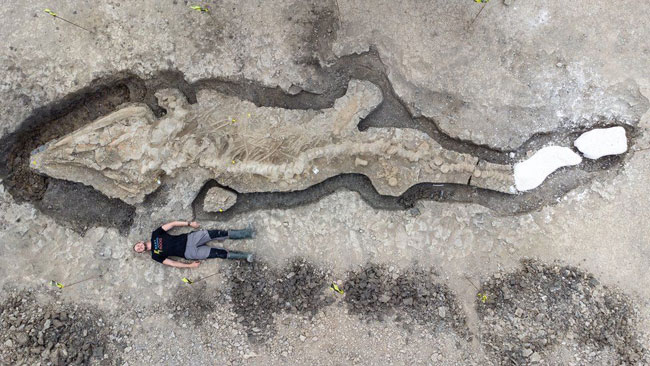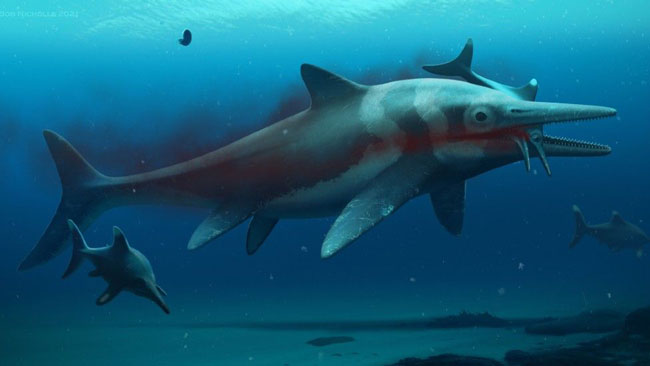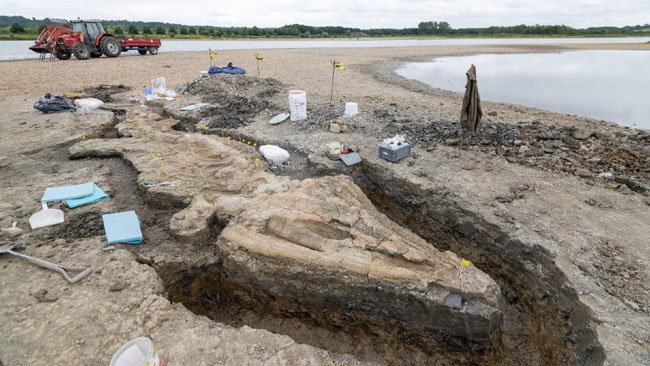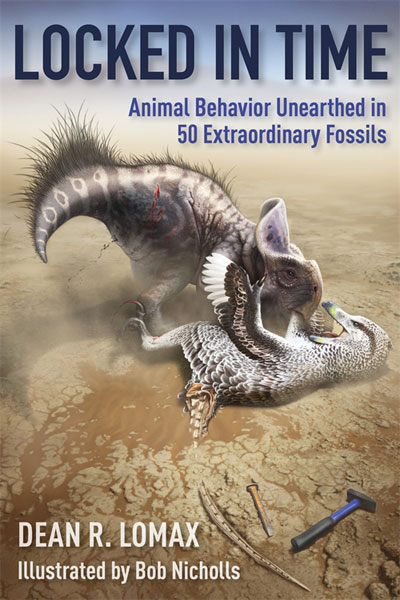The discovery of the remarkable Rutland ichthyosaur has featured in many news channels and media outlets. It is a stunning fossil specimen, demonstrating that even in a country like Britain, arguably the birthplace of geology and the science of palaeontology, a part of the world that has been extensively mapped, documented and studied, that there are still amazing fossils to be found.
This story highlights the many largely unsung individuals that bring to the attention of scientists, strange phenomena that they spot, often in the unlikeliest of places. In this case it was Joe Davis (Conservation Team Leader for Leicestershire and Rutland Wildlife Trust at the Rutland reservoir), who along with his colleague Paul Trevor spotted strange circular objects jutting out of the exposed Jurassic clay as they routinely inspected part of a drained lagoon back in February 2021.
These objects turned out to be bones from the spinal column, fortunately, Joe a career conservationist, was familiar with the skeletons of whales and dolphins and he had an inkling that these objects were organic in origin. The local council was called and asked whether they had a “dinosaur department” that could investigate further. Thus, was set in motion a series of events that led to award-winning ichthyosaur specialist Dr Dean Lomax setting up an exploratory dig at the site, the results of which led to a full-scale excavation over the summer.

Dr Dean Lomax provides the scale for an aerial shot of the Rutland ichthyosaur specimen. Picture credit: Anglian Water/Leicestershire and Rutland Wildlife Trust/Matthew Power Photography.
Picture credit: Anglian Water/Leicestershire and Rutland Wildlife Trust/Matthew Power Photography
An Extraordinary Marine Reptile Fossil
The ichthyosaur fossil is the largest and most complete ichthyosaur to have been found in the UK. It measures around 10.5 metres in length. As has been repeatedly stated in the plethora of media releases concerning this Jurassic monster, ichthyosaurs are not dinosaurs. Ichthyosaurs are aquatic reptiles that evolved from terrestrial ancestors. Their evolutionary origins remain obscure, but their fossil record covers most of the Mesozoic and the Rutland ichthyosaur happens to be the most complete skeleton of a large prehistoric reptile ever found in the UK.
This spectacular fossil discovery stands out well compared to the scrappy and fragmentary remains of Britain’s dinosaurs.

Some of the Rutland “Sea Dragon” excavation team. Left to right – Dr Emma Nicholls (Senior Curator of Natural Sciences at the Horniman Museum and Gardens, London), David Savory (Peterborough Geological and Palaeontological Group), Nigel Larkin (palaeontological conservator), Dr Dean Lomax (palaeontologist), Mick Beeson (Peterborough Geological and Palaeontological Group), Dr Mark Evans (palaeontologist at the University of Leicester), Emily Swaby (PhD student the Open University), and Darren Withers (Peterborough Museum). Picture credit: Anglian Water.
Picture credit: Anglian Water
A “Rosetta Stone” for the Temnodontosaurus Genus
The fossil specimen has been tentatively assigned to the species Temnodontosaurus trigonodon. If this proves to be the case, the identification will be confirmed when the fossils are fully cleaned and prepared, then this is the first T. trigonodon known from the British Isles.
The species Temnodontosaurus trigonodon was erected in 1843. Its fossils have been found in Germany and France, if the Rutland specimen proves to be this species it will extend the palaeogeographical range of T. trigonodon. In addition, the almost complete, articulated Rutland ichthyosaur will provide an extremely useful comparator when assessing Temnodontosaurus fossils. It will help to identify other large, but much less complete, ichthyosaur specimens housed in museums, acting as a “Rosetta Stone” for the genus.

The ichthyosaur specimen has been tentatively assigned to the species Temnodontosaurus trigonodon. T. trigonodon was an apex predator and it probably hunted other smaller ichthyosaurs. Picture credit: Bob Nicholls.
Picture credit: Bob Nicholls
A Huge Fossil but It’s Also the Little Details
These fossilised remains are not the first ichthyosaur fossils to have been found at Rutland Water, smaller, fragmentary material representing other species were found during construction of the reservoir. Once excavated and wrapped in plaster jackets the Rutland ichthyosaur was taken to a research facility where the job of preparing and restoring it will take place under the watchful supervision of conservator Nigel Larkin.
The bones and teeth may have been removed but the site can still provide a great deal of data. For example, the clay-rich rocks that contained the specimen represent deposits from the Whitby Mudstone Formation and analysis of microfossils preserved in the sediment have enabled researchers at the University of Birmingham to reliably date the Rutland ichthyosaur to 181.5 to 182 million years ago (Toarcian faunal stage of the Jurassic).
The composition of these microfossils indicates that this large predator lived in a tropical, marine environment with a rich and diverse ecosystem. Temnodontosaurus is thought to have lived far out to sea and away from the coast. It is hoped that further analysis of the matrix surrounding the fossil will provide more details of this animal’s palaeoenvironment.

The summer 2021 excavation of the Rutland ichthyosaur. The ventral elements of the skull can be seen in the foreground. This photograph was taken before prior to plaster encasement of the specimen and it being removed from the site. Picture credit: Anglian Water/Leicestershire and Rutland Wildlife Trust.
Picture credit: Anglian Water/Leicestershire and Rutland Wildlife Trust
Locked in Time
Palaeontologist Dr Dean Lomax who led the excavation, has recently published a book in collaboration with Bob Nicholls the artist that provided the Temnodontosaurus illustration.
It provides a fascinating analysis of fifty extraordinary fossils and what these discoveries can tell scientists about life in the past.
The book is available from Columbia University Press: Columbia University Press just search for Dean Lomax on this site.

Published by Columbia University Press “Locked in Time” examines 50 extraordinary fossils that provide a remarkable glimpse into the lives and behaviours of long extinct animals. Picture credit: The University of Manchester.
Picture credit: The University of Manchester
For models of ichthyosaurs and other marine reptiles: Buy Prehistoric Animal Models.






Leave A Comment